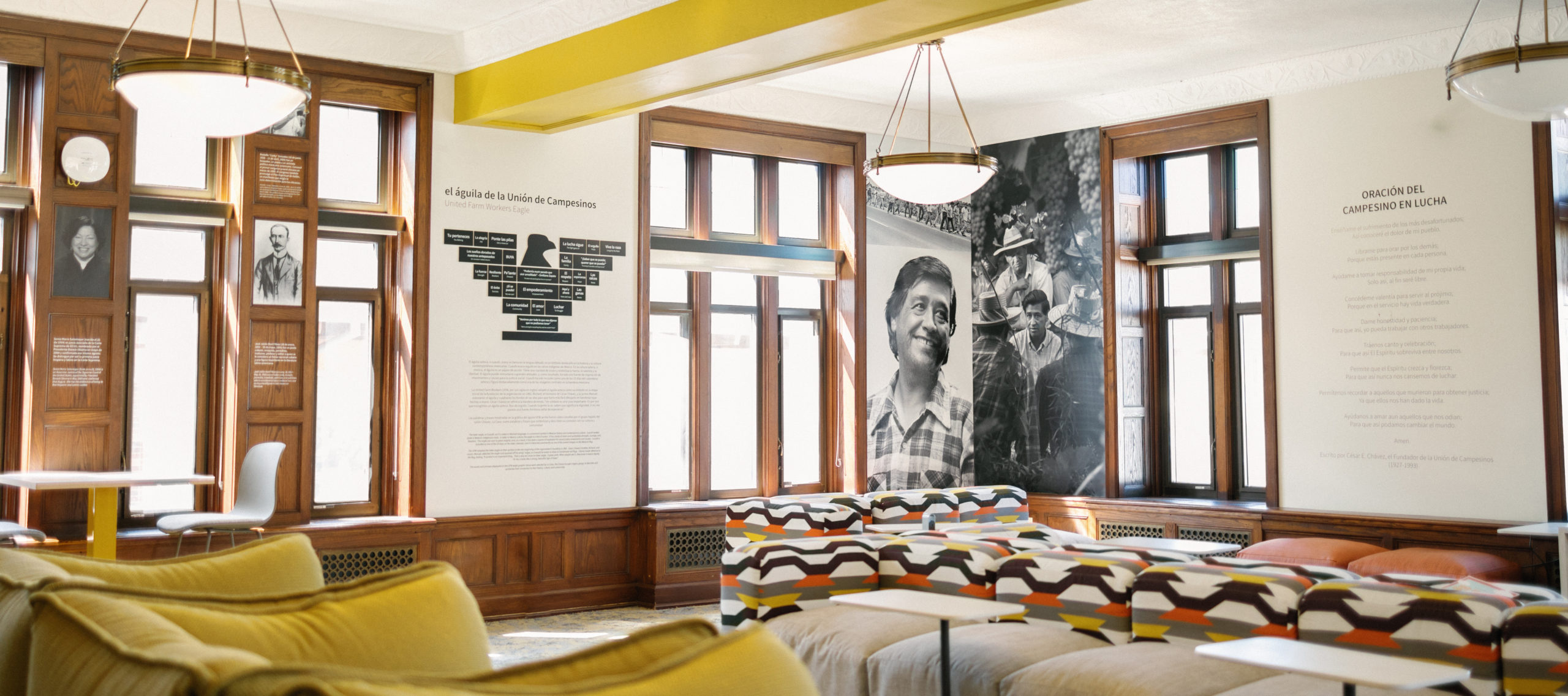The University of Michigan celebrated its bicentennial in 2017, making it the oldest institution of higher education in the state of Michigan and, in turn, witness to many social movements and milestones. Students have been the catalyst for much of the change on campus, particularly in advocating for the creation of spaces where their identities are valued and celebrated.
One of the foremost examples of such spaces at the University of Michigan is Housing’s multicultural lounge program, which has expanded to include 16 distinctive multicultural lounges since its launch in the early 1970s. More recently, Michigan Housing has embarked on their commitment to renovating all the multicultural lounges to keep them engaging and relevant for the changing student population.
Historical context
The national climate in the 1950s and 1960s was heavy with calls for racial justice and human rights, sentiments shared by many Michigan students. Following the assassination of Rev. Dr. Martin Luther King Jr., a group of predominantly Black and African American students, staff, and faculty began protesting, voicing their disillusionment with the university and calling for more funding and support of Black and African American students and hiring of Black faculty members. This was the beginning of the first wave of the Black Action Movements (BAM). BAM-I, as the first of the three eventual movements became known, issued a list of 12 demands to the administration. The university eventually agreed to three and also formed two new housing programs for Black and African American students, including the creation of the first multicultural lounge in 1971.
The multicultural lounge program has continued to evolve in the years since. For example, as the student body has become more diverse, the program has become more representative of different populations and identity-based student groups across campus, including Asian American, Arab American, and Latinx populations. Today, there are 16 multicultural lounges across the Michigan campus, many associated with a particular historical figure.
These and other changes underscore the importance of adaptability within higher education. To remain relevant and effective on our campuses, we must address and anticipate the changing landscape of not only our campus communities but also society as a whole. Currently, Michigan Housing is using an adaptive framework to update all of their multicultural lounges. The framework falls into four major categories: (1) physical renovation, (2) accessibility, (3) storytelling, and (4) partnerships, each reflective of the diverse voices of our student body and broader societal context.
Physical renovation
One of the most noticeable components of the renovation process involves changes within the physical space. Physically transforming spaces enables Michigan Housing to create more welcoming and inclusive environments while also using physical design to tell a story.
Ambatana – The Afro American Multicultural Lounge is one of the oldest multicultural lounges on campus, founded in 1972. It is located on the ground floor level of a residence hall at the end of a long hallway that was not particularly warm and inviting; in fact, many students did not realize the multicultural lounge was there. One of the primary goals was to transform not only the multicultural lounge itself but also the exterior hallway leading to it. Michigan Housing connected with local artists from Southeast Michigan and Detroit to create original murals on the walls of the hallway, including a mural of University of Michigan students walking toward the multicultural lounge, inviting all students to learn and engage. Outside this multicultural lounge are study alcoves that include seating with high backs and sides to provide additional privacy and flexibility for students.
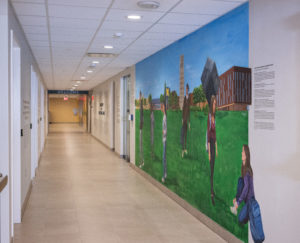
Hallway photo at South Quad leading to Ambatana – The Afro American Multicultural Lounge
Designing the physical space is about many types of comfort, according to Jennifer Catalano, a senior interior designer. “Not only comfort through design elements and storytelling,” she explained, “but comfort down to the details of the seat depth in relation to how it touches the back of someone’s knees, seat width and arm height of a lounge chair, sofa plushness, lighting level, and technology.”
More broadly, Michigan Housing incorporated trends from student feedback over recent years in several common updates across the multicultural lounge renovations. These include laptop tables, which enable students to work from more comfortable positions in armchairs and couches; charging stands, which increase the number of electrical plugs in the room, extend their reach, and free up space by limiting the number of cords to cross over; and technology, such as TVs, projectors, and Zoom connection, which expands opportunities to engage students during programs and events.
These and other changes to the multicultural lounges’ physical appearances and environments are very noticeable to students. The renovated multicultural lounges have seen increased usage both in day-to-day use and reservation requests for programs, meetings, and events. This evidence, along with verbal feedback from students about the physical changes to the multicultural lounges, shows that our evolving work is making a direct impact on our students’ experiences.
Accessibility
In the intricate process of renovating the multicultural lounges, a cornerstone has been ensuring accessibility. Accessible spaces can serve the diverse needs of a wide array of people, thereby amplifying their impact. This imperative became exceptionally clear during the renovation of the Edward Said Multicultural Lounge, in the summer of 2022.
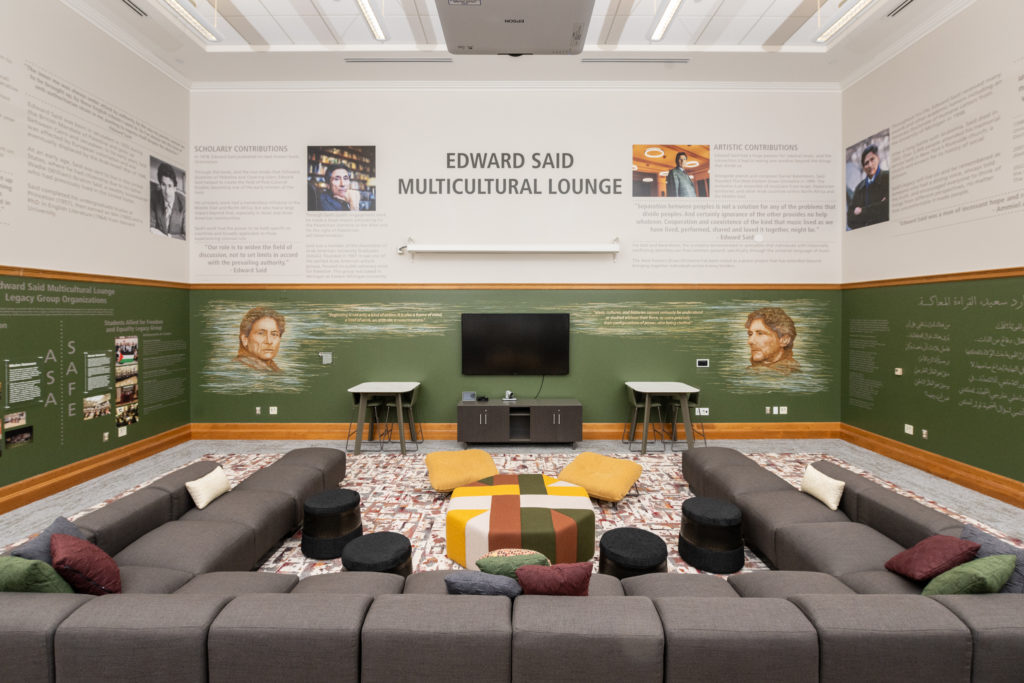
Edward Said Multicultural Lounge, North Quad
Originally situated on a third-story residential floor, the Edward Said Multicultural Lounge faced a significant accessibility challenge. Its placement on a residential floor limited its reach, creating a barrier not only for those with particular mobility or accessibility needs, but public access as well. Therefore, a pivotal decision was made to relocate this multicultural lounge to an available room on the ground floor, strategically positioned right off a heavily trafficked street on campus. This removed the need for residents and off-campus students to navigate through the many floors of the residence hall.
Another example of how the multicultural lounge program became more accessible as part of this commitment was that card swipe access was previously limited to students who took an orientation about the history of the program. This created a barrier for many students and did not increase the multicultural lounges’ use. Now, all residents within any given residence hall automatically have access to the multicultural lounges in their building.
As with their physical renovations, these efforts to make the multicultural lounges more easily accessible to all members of the residential and campus community have led to a noticeable increase in both general use and reservation requests. Not only do these changes address the immediate needs of the community, but they also help ensure that the spaces will remain relevant for the evolving student population of the future.
Storytelling
Each multicultural lounge is associated with a particular cultural group or historical figure, and therefore the histories and narratives in the lounges serve a vital purpose. Michigan Housing is responsible for designing these spaces to respectfully and accurately represent the identities that the multicultural lounges are dedicated to.
For example, in the stories told in the Abeng Minority Culture Lounge and the Asubuhi Multicultural Lounge, we find representations of the past, present, and future—testaments to the continual reflection and adaptation of spaces at the University of Michigan.
The Abeng Minority Culture Lounge tells stories of the past, weaving together more than 400 years of Black and African American history in the United States. As a space dedicated to recognizing the struggles and resilience of these communities, the Abeng Minority Culture Lounge serves as a narrative of the societal changes and challenges faced over centuries. It highlights the importance of acknowledging the past to understand the present, emphasizing the continuous evolution of perspectives and identities.
On the other hand, the Asubuhi Multicultural Lounge embodies the future within the context of student body changes, representing the aspirations and dreams of a diverse and evolving student population. It serves as a canvas for the student voice, incorporating the dynamic narratives that shape the current cultural landscape. The Asubuhi Multicultural Lounge reflects the university’s commitment to remain relevant by embracing the diversity that defines the contemporary student experience.
Both of these multicultural lounges showcase the importance of storytelling within the evolution of physical spaces. The dialogue between past and future emphasizes the continual adaptation required to create environments that resonate with the narratives on campus.
Partnerships
Partnerships have been a key component to curating multicultural lounges that reflect changing student needs, while also maintaining connections to history. Perhaps the most valuable partnerships and relationships Michigan Housing staff form is with students. “Asking for feedback and having open discussions throughout the design process is key to getting the design right,” said Catalano. “If there are elements we didn’t get right, the students challenge us to think critically and change certain elements.”
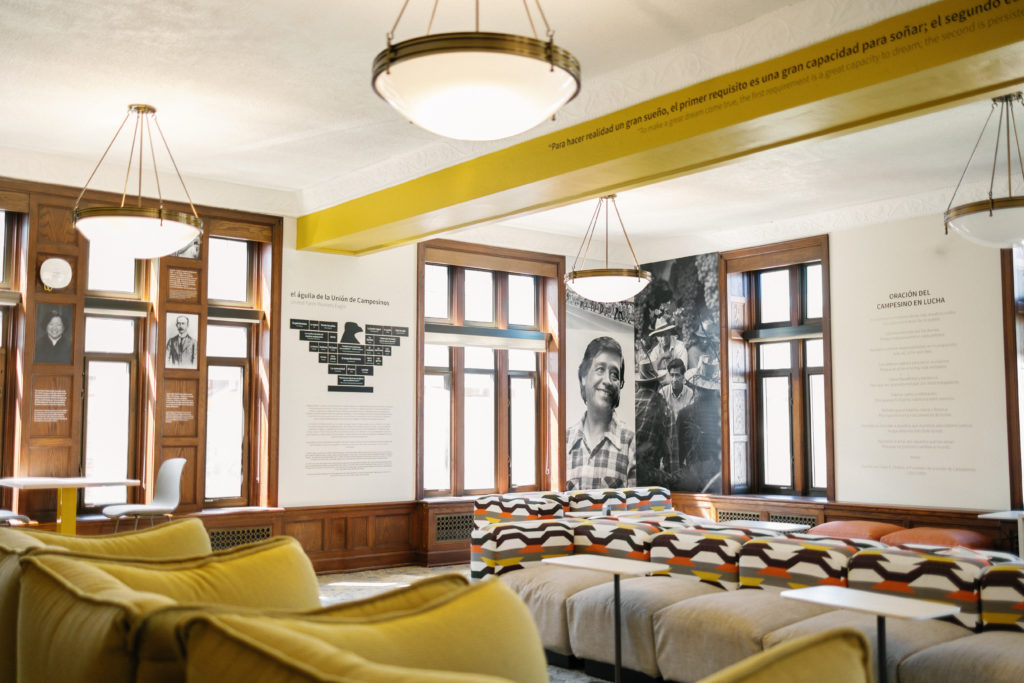
César Chávez Multicultural Lounge, Mosher Jordan Hall
A prime example of responding to student feedback occurred during the renovation of the César Chávez Multicultural Lounge. After drafting the storytelling elements, the information was shared with a group of students who noticed English was put above the Spanish translation. They advocated for Spanish to be the primary language featured in the multicultural lounge, with English translations below, as Chávez’s first language was Spanish.
This is a lesson which has been implemented in other multicultural lounges that feature languages other than English. “It starts and ends with student feedback, which helps us adapt and recalibrate our thinking on future projects,” said Catalano.
The original Yuri Kochiyama Multicultural Lounge did not share detailed information about Kochiyama’s life and legacy. Students said they wanted to see her story more prominently in the renovation and suggested showcasing stories of other Asian and Asian American activists as well. We worked with students to gather a list of activists from a broad array of Asian backgrounds, further challenging students who visit this multicultural lounge to understand the depth of Asian culture beyond Southeast Asian countries.
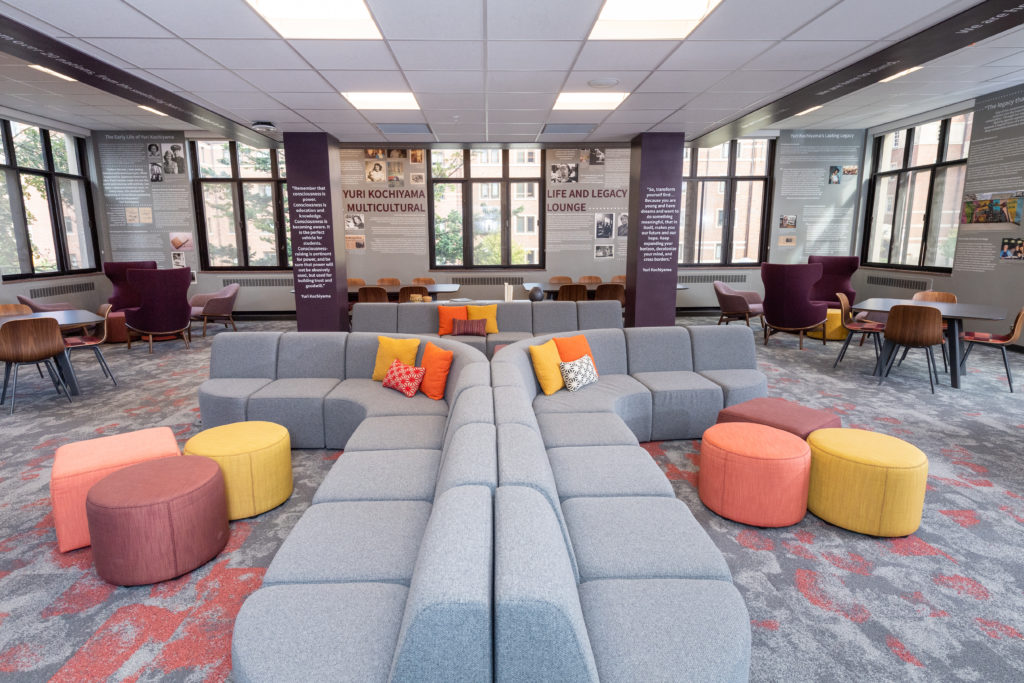
Yuri Kochiyama Multicultural Lounge, South QuadKochiyama Lounge at South Quad
Partnerships are vital to adapting to shifts in student and societal needs because they enable us to work together from different experiences and perspectives. Identifying gaps in knowledge and working to fill them through intentional partnerships is one way to create a more complete narrative. Without involving students in these processes, we would miss the perspective of those individuals who primarily engage in the multicultural lounges.
Looking ahead
At the heart of Michigan Housing’s work in the multicultural lounges is sharing the history of each space while engaging ever-changing student populations in sustainable ways. Being open to learning and adapting is a big step toward creating environments that are welcoming and inclusive. We want to be able to welcome alumni back to the multicultural lounges and have them remember the spaces as they experienced them as students, even if they look a little different. Through storytelling and partnerships, Michigan Housing has intentionally both preserved the history of each multicultural lounge and expanded on the stories within them. The multicultural lounges’ physical and accessibility updates, in turn, have enabled us to broaden the reach of the program to be more inclusive of a wider audience and increase the use of many multicultural lounges.
The University of Michigan’s multicultural lounge program was born out of student advocacy. Continuing to listen to student voices has been crucial to maintaining this program for the past 50 years. As the program embarks upon its next 50, they are committed to anticipating and adapting to campus and societal changes by being open to learning and engaging with students, alumni, and the campus community.
To learn more about the Multicultural Lounge Program at the University of Michigan, visit their new website!
Website: https://multicultural-lounges.housing.umich.edu/
Elizabeth Beckett, M.S., serves as the senior program manager for inclusive spaces in Diversity & Inclusion – Michigan Housing at the University of Michigan. Elizabeth supports the renovations of the multicultural lounges, including researching, writing, and gathering feedback from students, alumni, and campus stakeholders. She can be reached at [email protected].
Isabella Schilling, M.A., serves as the program manager for inclusive spaces in Diversity & Inclusion – Michigan Housing at the University of Michigan. Isabella works primarily with the day-to-day management of the multicultural lounge program, including supervision of student staff, and assisting with the renovation process. She can be reached at [email protected].
